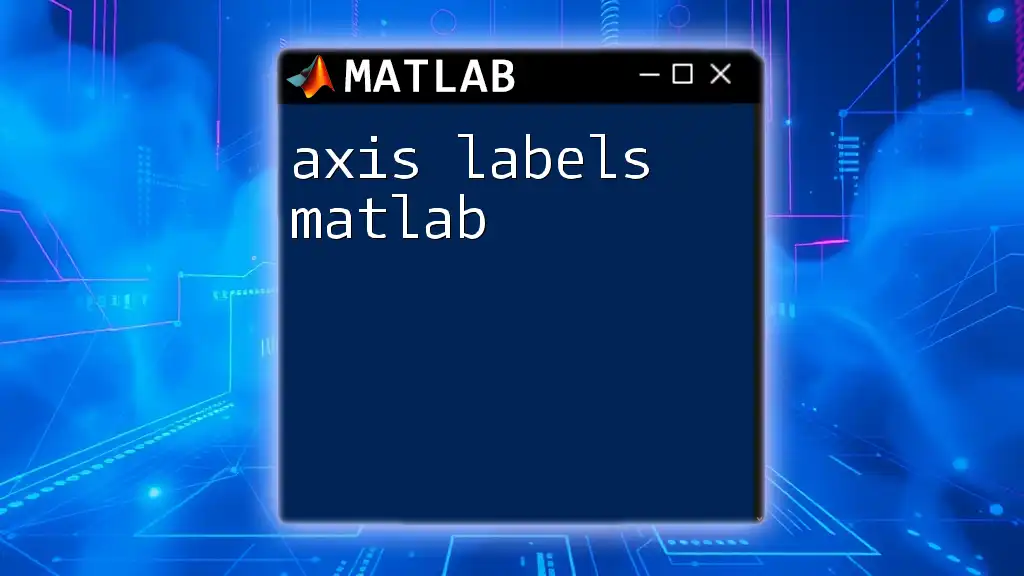The `bwlabel` function in MATLAB labels connected components in a binary image, allowing for easy identification and analysis of distinct regions.
Here's a code snippet demonstrating its use:
% Read and convert the image to binary
BW = im2bw(imread('image.png'));
% Label connected components
[L, num] = bwlabel(BW);
% Display the labeled image
imshow(label2rgb(L));
title(['Number of connected components: ', num2str(num)]);
Understanding Binary Images
A binary image is a digital image that has only two possible pixel values: typically 0 (representing the background) and 1 (representing the foreground). This simple format allows easier processing for various image analysis tasks.
When working with binary images, it is crucial to properly visualize the structure and arrangement of components. For instance, a simple binary image may represent various objects on an image, such as shapes or other forms, where each component needs identification and labeling for further analysis.

What is bwlabel?
The `bwlabel` function is a vital tool in MATLAB for labeling connected components in binary images. It assigns a unique integer label to each connected group of pixels, making it easier to identify and analyze these components separately. This function is particularly important in the fields of image processing and computer vision.
The key features of `bwlabel` include:
- The ability to distinguish between foreground objects based on connectivity.
- The option to specify the type of connectivity, either 4-connected or 8-connected, providing flexibility based on the needs of the analysis.

Syntax of bwlabel
The basic syntax for using `bwlabel` is:
L = bwlabel(BW)
In this syntax:
- `BW` is the input binary image that you want to analyze and label.
- `L` is the output label matrix, where each connected component in the binary image is assigned a unique integer label.
You can enhance the functionality of `bwlabel` further by specifying connectivity. The command becomes:
L = bwlabel(BW, connectivity)
In this case, `connectivity` can be either `4` or `8`, depending on the desired connection criteria for neighboring pixels.

How to Use bwlabel
To effectively use `bwlabel`, follow these steps:
1. Preparing the Binary Image
Before applying `bwlabel`, ensure your image is in binary format. You can use the `im2bw` function to convert a grayscale image to a binary image. For example:
BW = im2bw(imread('image.png'));
2. Applying bwlabel
Once you have the binary image, you can easily apply `bwlabel`:
L = bwlabel(BW);
3. Visualizing the Output
After labeling the components, it’s essential to visualize the result. You can use the `imshow` function combined with `label2rgb` to display the labeled image with distinct colors for different components:
imshow(label2rgb(L));
Example: Using bwlabel
Here’s a complete example demonstrating how to use `bwlabel` in a MATLAB script. This example utilizes a sample binary image of coins to illustrate the labeling process:
% Read the binary image
BW = im2bw(imread('coins.png'));
% Label connected components
L = bwlabel(BW);
% Display labeled image
figure;
imshow(label2rgb(L));
title('Labeled Image');
In this example, the `coins.png` image is converted to a binary form, labeled using `bwlabel`, and finally displayed, showing how each pixel group has been assigned a unique label.

Different Options for Connectivity
The `bwlabel` function allows users to choose between 4-connectivity and 8-connectivity. These options define how pixels are considered connected:
- 4-connectivity: Pixels are connected if they touch at their edges (i.e., left, right, above, and below).
- 8-connectivity: Pixels are connected if they share an edge or a corner (including diagonals).
To specify connectivity in your code, simply add the second argument:
L = bwlabel(BW, 4); % For 4-connected components
or
L = bwlabel(BW, 8); % For 8-connected components
Choosing the appropriate connectivity type is crucial, as it can significantly affect the labeling outcome based on your specific application needs.

Practical Applications of bwlabel
The `bwlabel` function finds applications across various fields, owing to its ability to distinguish and label segmented components in binary images. Some notable fields include:
- Medical Image Analysis: Labeling anatomical structures or tumors in medical imaging.
- Object Detection: Identifying and distinguishing objects in scenes for autonomous systems.
- Shape Analysis: Conducting analyses on the shape and size of objects, often for applications in manufacturing and quality control.

Troubleshooting Common Issues
When working with `bwlabel`, you may encounter specific challenges, such as incorrect labeling of components or performance issues with larger datasets. Here are a few tips to address these concerns:
-
Incorrect Labeling: This may occur if the binary image is not properly thresholded or has noise. Using preprocessing techniques like morphological operations or threshold optimization can enhance the binary image's quality.
-
Performance Considerations: For large images, consider optimizing your code by implementing methods such as parallel processing or reducing the resolution of your images where possible to increase the speed of labeling.

Conclusion
In summary, `bwlabel` is an essential function in MATLAB for image processing tasks that require component labeling in binary images. By understanding how to properly use and implement `bwlabel`, you can significantly enhance your image analysis capabilities. Practicing with different binary images will help you master this function and understand its importance in various applications.

Call to Action
We encourage you to experiment with `bwlabel` in your own projects and explore its powerful capabilities further. Feel free to share your experiences and insights, and subscribe for more MATLAB tutorials and quick command guides to enhance your programming journey!

















